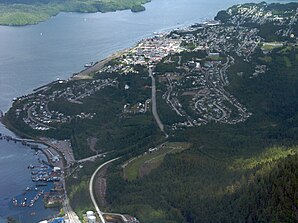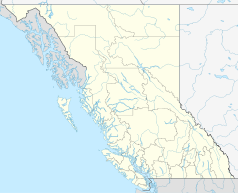Prince Rupert
| Prince Rupert | ||
|---|---|---|
 |
||
| Location in British Columbia | ||
|
|
||
| State : |
|
|
| Province : | British Columbia | |
| Regional District : | North Coast | |
| Coordinates : | 54 ° 19 ′ N , 130 ° 19 ′ W | |
| Height : | 40 m | |
| Area : | 54.9 km² | |
| Residents : | 12,508 (as of 2011) | |
| Population density : | 227.8 inhabitants / km² | |
| Time zone : | Pacific Time ( UTC − 8 ) | |
| Postal code : | V8J | |
| Foundation : | 1910 (incorporated) | |
| Mayor : | Jack Mussallem | |
| Website : | www.princerupert.ca | |
Prince Rupert is a small town in the western Canadian province of British Columbia . It is located on Kaien Island and received the right to local government on March 10, 1910 (incorporated). The place was named after Ruprecht von der Pfalz, Duke of Cumberland .
It is also known as the “city of rainbows”, as there is very high rainfall here (2500 mm p. A.). It is one of the starting points for the Inside Passage as well as for whale watching and tours in the Great Bear Rainforest .
Prince Rupert is located in the traditional Tsimshian area and is the Canadian city with the highest proportion of indigenous people. This is around 32%.
history
Early history
Traces of settlement can be found around 3000 BC. Trace back to BC. At that time, the Tsimshians , who are still living around Prince Rupert, lived in the region. Extensive excavations took place from 1966 to 1978. A warrior's grave from around AD 200 was found in the harbor. Next to the warrior was a woman's skull, possibly a war trophy. There were also two clubs, one made from the jaw of an orca , a dagger, a copper bracelet, a goat horn and a hammer stone. In addition, remnants of armor were found such as the Tsimshian warriors wore around 1800. Around 14,000 m³ of cultural debris were searched, with 500 wood artifacts uncovered at the nearby Lachane site alone .
A total of around 200 houses were found, each of which was leveled after an average service life of 25 years, thus forming a hill. There was also waste. Another source is the “pit cache” for winter supplies, mostly fish.
One of the most important collections on the regional Tsimshian culture is the Dundas Collection . It goes back to the Scottish cleric Reverend Robert James Dundas , who lived in Old Metlakatla not far from Prince Rupert in 1863 . He acquired numerous pieces from William Duncan , an Anglican missionary who obtained numerous ritual objects and works of art from his Tsimshian followers. Dundas brought the art treasures to Edinburgh, Scotland . His great-grandson Simon Carey sold the collection at Sotheby’s in New York in October 2006 for more than $ 7 million - the highest price ever for a First Nation art collection. Canadian museums and organizations bought the majority. The exhibition of the objects took place in consultation with the elders of the Tsimshian tribes of Lax Kw'Alaams and Metlakatla.
First Europeans, end of Tsimshian dominance
When the first Europeans came to the Tsimshian area at the end of the 18th century, most of them lived around what is now Prince Rupert Harbor and the Kitselas Canyon . They were divided into ten tribes. They moved here to participate in the fur trade, but also because salmon were abundant here. The large village measured about 180 by 60 m, and, as usual on the west coast, it stretched along the seashore.
The Tsimshians ruled the region and monopolized the trade until 1862 when a catastrophic smallpox epidemic killed around 80% of them.
In the same year, William Duncan began his missionary work in nearby Metlakatla , where he was supported by Chief Ligeex. The place became the largest settlement in the region. But in 1887 the missionary moved with 800 of the 1,100 parishioners to US territory and founded New Metlakatla , or the Independent Native Church .
Foundation of the village and railway construction
It was only with the construction of a railway connection, the Grand Trunk Pacific Railway , that numerous non-indigenous people came to the region. The current location was founded by Charles M. Hays , the regional director of the Grand Trunk Pacific Railway (GTP), which completed the 4,800 km east-west link from Winnipeg to Prince Rupert in 1914. The latter formed the western end point of the transcontinental railway line and replaced Port Essington on the Skeena River as the center of the region. Prince Rupert received city rights on March 10, 1910. The founder planned to expand the city into a tourist center on the west coast, but was killed when the Titanic sank on April 15, 1912.
A road connection (to Terrace ) was only created during the Second World War , when US troops were used to establish a fast connection to the Alëuts , this highway is now part of the Yellowhead Highway .
In 1947 a pulp mill was built and docks for coal and grain were built, but the focus of economic activity increasingly shifted to the raw materials industry and tourism, as the fish and timber industries collapsed in the 1990s. Up until then, Prince Rupert lived largely on salmon and halibut , which were found in large numbers until the early 1980s. With the decline in stocks, there were conflicts between fishermen from Canada and those from the USA and Alaska . In July 1997, Canadian fishermen blocked the Alaska Marine Highway Ferry , the Malaspina , to protest American fishing methods and volumes. The US Coast Guard has a base in nearby Ketchikan .
With the increasing export of raw wood to the USA, the wood processing industry also collapsed, so that the number of unemployed rose and the population began to migrate. Between 1996 and 2004 the region experienced an economic low point, but the construction of a container port was announced in April 2005 and cruises were to be intensified. The region also benefited from the boom in Asia, with Prince Rupert acting as an export and import port.
Demographics
The census in 2011 showed a population of 12,508 in the small town, 2.4% less than in 2006.
economy
The main branches of industry are the fishing industry, maritime transport and port industries, and tourism.
traffic
The port is the north-westernmost ice-free seaport in Canada. The Prince Rupert Port Authority is the sponsor . There are regular ferry connections to several ports on the coast of Alaska and Canada as far as Vancouver . The port is also the starting point for the Inside Passage .
Prince Rupert is the starting point of the long-distance tourist train in the direction of Prince George - Jasper . Officially, the train no longer bears the train name since 2009, since almost all train names were deleted by VIA Rail Canada at that time , but it is still used in tourist marketing. Via this connection, the place has, with a change, connection to the rest of the North American railway network.
Prince Rupert Airport (YPR / CYPR) regional airport is located on Digby Island .
Culture
The Museum of Northern British Columbia is in Prince Rupert .
Climate table
| Prince Rupert, British Columbia | ||||||||||||||||||||||||||||||||||||||||||||||||
|---|---|---|---|---|---|---|---|---|---|---|---|---|---|---|---|---|---|---|---|---|---|---|---|---|---|---|---|---|---|---|---|---|---|---|---|---|---|---|---|---|---|---|---|---|---|---|---|---|
| Climate diagram | ||||||||||||||||||||||||||||||||||||||||||||||||
| ||||||||||||||||||||||||||||||||||||||||||||||||
|
Monthly average temperatures and rainfall for Prince Rupert, British Columbia
|
|||||||||||||||||||||||||||||||||||||||||||||||||||||||||||||||||||||||||||||||||||||||||||||||||||||||||||||||||||||||||||||||||||||||||||||||||||||||||||||||||||||
literature
- Dawn Hassett / FWM Drew: Totem Poles of Prince Rupert , Prince Rupert: Museum of Northern British Columbia 1982
Web links
- Prince Rupert ( English, French ) In: The Canadian Encyclopedia .
- Website of the municipality (English)
- Prince Rupert City and Regional Archives
- Contributions to history from the Prince Rupert Library
- Prince Rupert & District Chamber of Commerce
- Prince Rupert Port Authority
- Tourism in Prince Rupert

